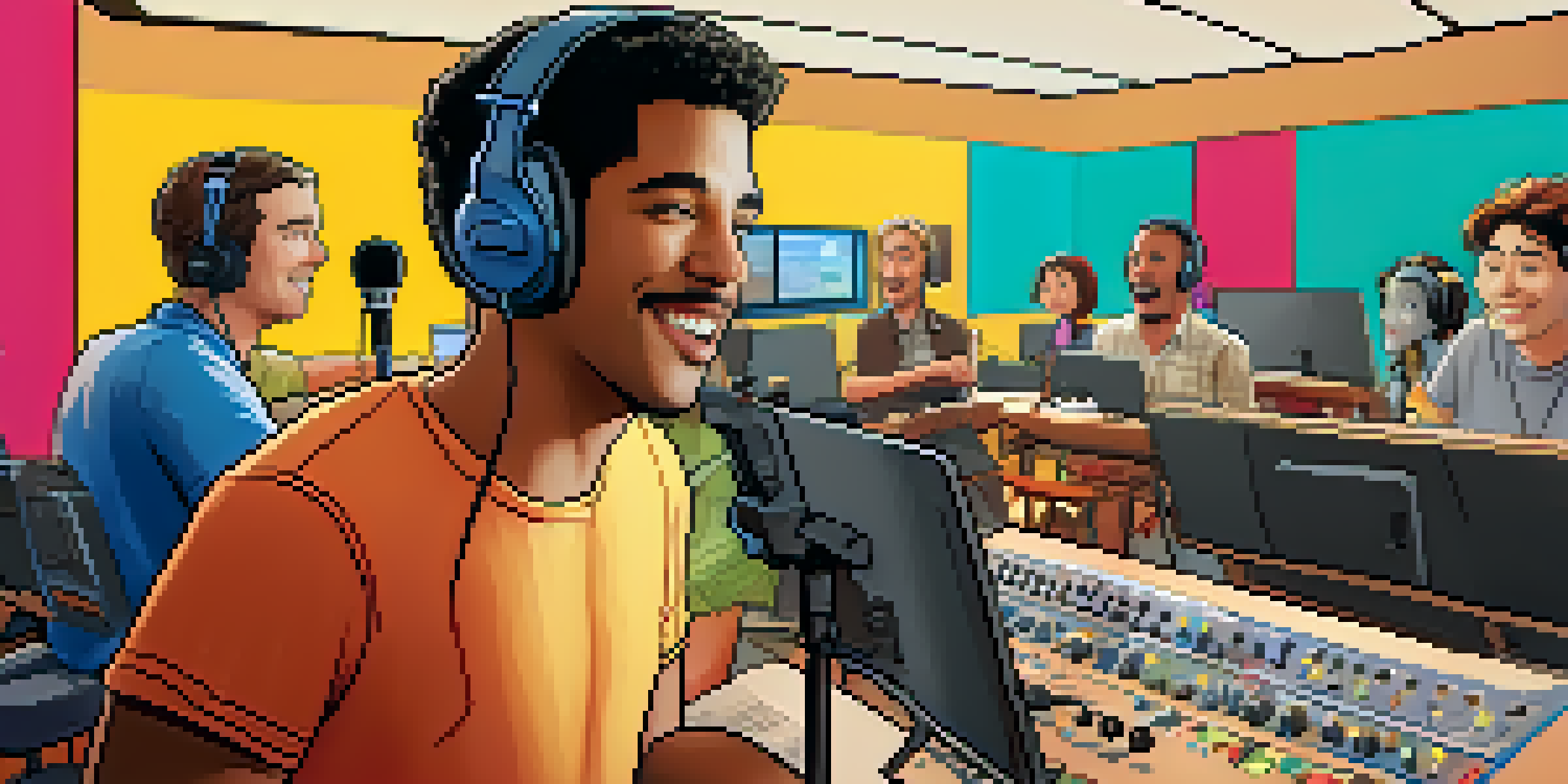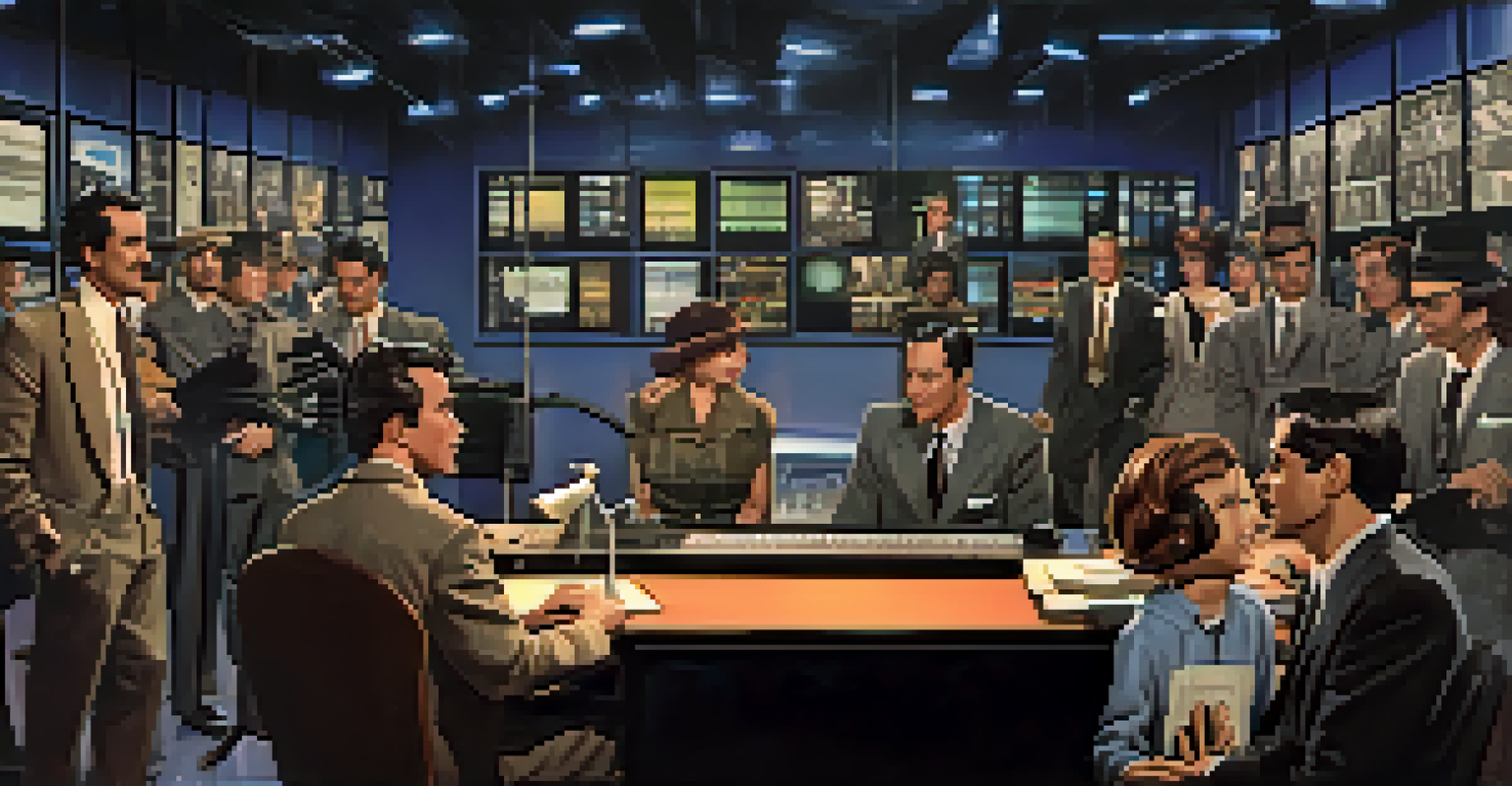The Role of Voice Acting in Animated Film Success

Voice Acting: The Heartbeat of Animated Characters
Voice acting is crucial because it breathes life into animated characters. Without the right voice, a character can feel flat or unrelatable, making it hard for audiences to connect. Think of iconic characters like Woody from 'Toy Story' or Elsa from 'Frozen'—their unique voices are integral to their identities and stories.
Voice acting is the art of creating a character's soul with just your voice.
The choice of voice actor can evoke specific emotions and traits that enhance the character's persona. For instance, a deep, gravelly voice might suggest strength and authority, while a high-pitched, cheerful voice can convey innocence and joy. This layer of personality adds depth that visuals alone cannot achieve.
Ultimately, the right voice transforms a mere drawing into a beloved character, making viewers invest emotionally in their journeys. When audiences hear a character’s distinct voice, they instantly recognize and remember them, which is a vital aspect of successful storytelling in animated films.
The Influence of Star Power on Box Office Performance
Star power in voice acting can significantly impact a film's box office success. When a well-known actor lends their voice, it often attracts their fanbase, which can lead to higher ticket sales. This phenomenon can be likened to the way a celebrity endorsement boosts a product's appeal.

However, it’s not just about the star’s name; their ability to convey emotion and character nuances matters greatly. An A-list actor might draw audiences in, but if their performance lacks depth, the film could still fall flat. Thus, the combination of talent and star power is essential for achieving both commercial success and critical acclaim.
Voice Acting Gives Characters Life
The right voice transforms animated characters, making them relatable and memorable for audiences.
For example, the ensemble cast of 'The Incredibles' featured renowned actors like Craig T. Nelson and Holly Hunter, whose performances resonated with audiences. Their star power, coupled with exceptional voice acting, played a pivotal role in the film becoming a beloved classic.
Creating Emotional Connections Through Voice
Voice actors have the unique ability to evoke emotions through their performances, creating a connection between the audience and the characters. This emotional resonance is often what keeps viewers engaged and invested in a film's storyline. In animated films, where visual cues are limited, voice acting becomes the primary tool for conveying feelings.
The best thing about animation is that you can create any world you can imagine, and you can bring it to life with the sound of a voice.
Consider the poignant scenes in 'Up', where the voice acting captures the essence of love, loss, and adventure. The heartfelt delivery of lines can bring tears to viewers' eyes, illustrating how powerful a well-executed performance can be. It’s not just dialogue; it’s about embodying the character’s journey and emotions.
This emotional connection can drive audience loyalty, leading to repeat viewings and word-of-mouth recommendations. When viewers feel moved by a character's voice, they are more likely to share that experience with friends and family, further amplifying the film's success.
The Art of Voice Direction in Animated Films
Voice direction plays a pivotal role in ensuring that voice actors deliver performances that align with the film's vision. A skilled director guides actors to explore emotional ranges, timing, and character nuances, ensuring their voices match the animation perfectly. This collaborative effort is akin to a conductor leading an orchestra, where every element must harmonize.
For instance, during the production of 'Zootopia', the director encouraged the voice actors to improvise, which led to memorable moments that enhanced the film. This level of creative freedom allows actors to bring authentic emotion and spontaneity to their roles, resulting in performances that resonate with audiences.
Star Power Boosts Box Office Success
Well-known actors can attract audiences, but their emotional delivery is essential for a film’s overall success.
Effective voice direction not only enhances the quality of individual performances but also contributes to the overall cohesion of the film. When every voice feels purposeful and aligned with the storytelling, it elevates the entire animated experience.
Cultural Impact of Voice Acting in Global Animation
Voice acting transcends borders, allowing animated films to resonate with diverse cultures. When films are dubbed or localized, skilled voice actors can adapt the original characters' charm and essence for different audiences. This cultural adaptation helps ensure that the film feels relatable, no matter where it is viewed.
For example, the Japanese anime 'Spirited Away' was effectively localized for Western audiences, with voice actors capturing the film's magic while maintaining cultural nuances. Such adaptations can open doors to new fanbases, expanding the film's reach and success across the globe.
Moreover, the cultural significance of voice acting can contribute to conversations about representation and diversity in animation. By featuring diverse voice talents, films can authentically portray various cultures, enriching the storytelling experience for everyone.
The Evolution of Voice Acting Techniques in Animation
Voice acting techniques have evolved significantly, thanks to advancements in technology and animation styles. Today, voice actors often record their lines in isolation, but that wasn't always the case. In the past, actors would record together, allowing for more natural interactions and chemistry, reminiscent of a live performance.
Modern techniques also include the use of motion capture, where actors' physical performances are translated into animated characters. This method brings an additional layer of realism to the character's voice and movements, enhancing audience engagement. It's like blending live-action performance with animated storytelling, creating a unique viewing experience.
Cultural Adaptation Enhances Appeal
Skilled voice actors can localize characters to resonate with diverse audiences, enriching the storytelling experience.
As animation continues to evolve, so too will voice acting techniques. With innovations like artificial intelligence and machine learning, the future may hold even more exciting possibilities for how stories are told through voice in animated films.
The Lasting Legacy of Voice Actors in Animation
Voice actors often leave a lasting legacy, becoming synonymous with the characters they portray. Iconic performances can define a character for generations, creating a deep cultural imprint. For many, the voices of characters from childhood remain cherished memories, showcasing the profound impact of voice acting.
Consider the late Robin Williams, whose portrayal of the Genie in 'Aladdin' is still celebrated today. His unique blend of humor and heart brought the character to life, making it unforgettable. Such performances not only shape the character's identity but also influence future generations of voice actors.

As audiences continue to celebrate animated films, the contributions of voice actors will remain integral to the storytelling landscape. Their ability to create memorable characters ensures that the magic of animation endures, inspiring future filmmakers and voice actors alike.